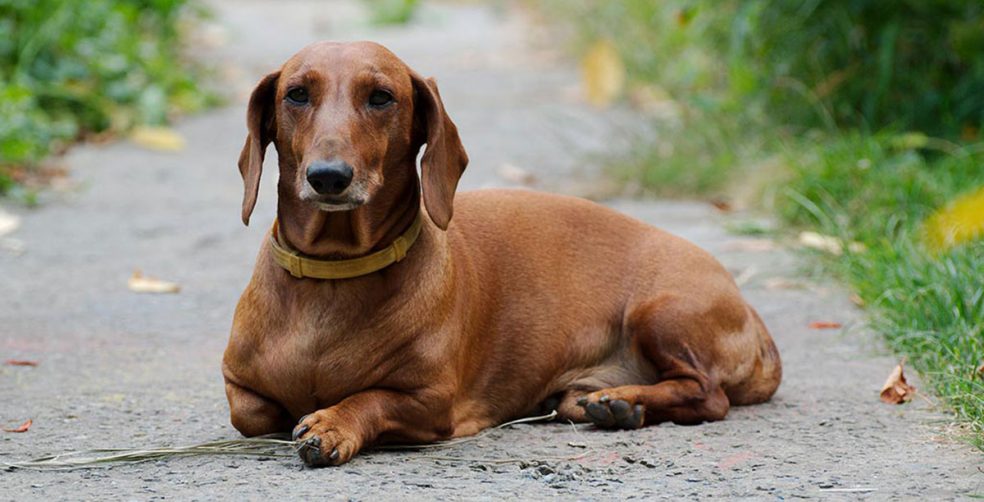Are you thinking about adding a dachshund to your family? Or are you already living with one? Then you’ve come to the right place! I love our little miniature dachshund Cocoa, and I love helping others understand the breed (all sizes of it). This article has a bit of everything you need to know, to take care of your dog and live the dachshund lifestyle. - By Travis Neighbor Ward
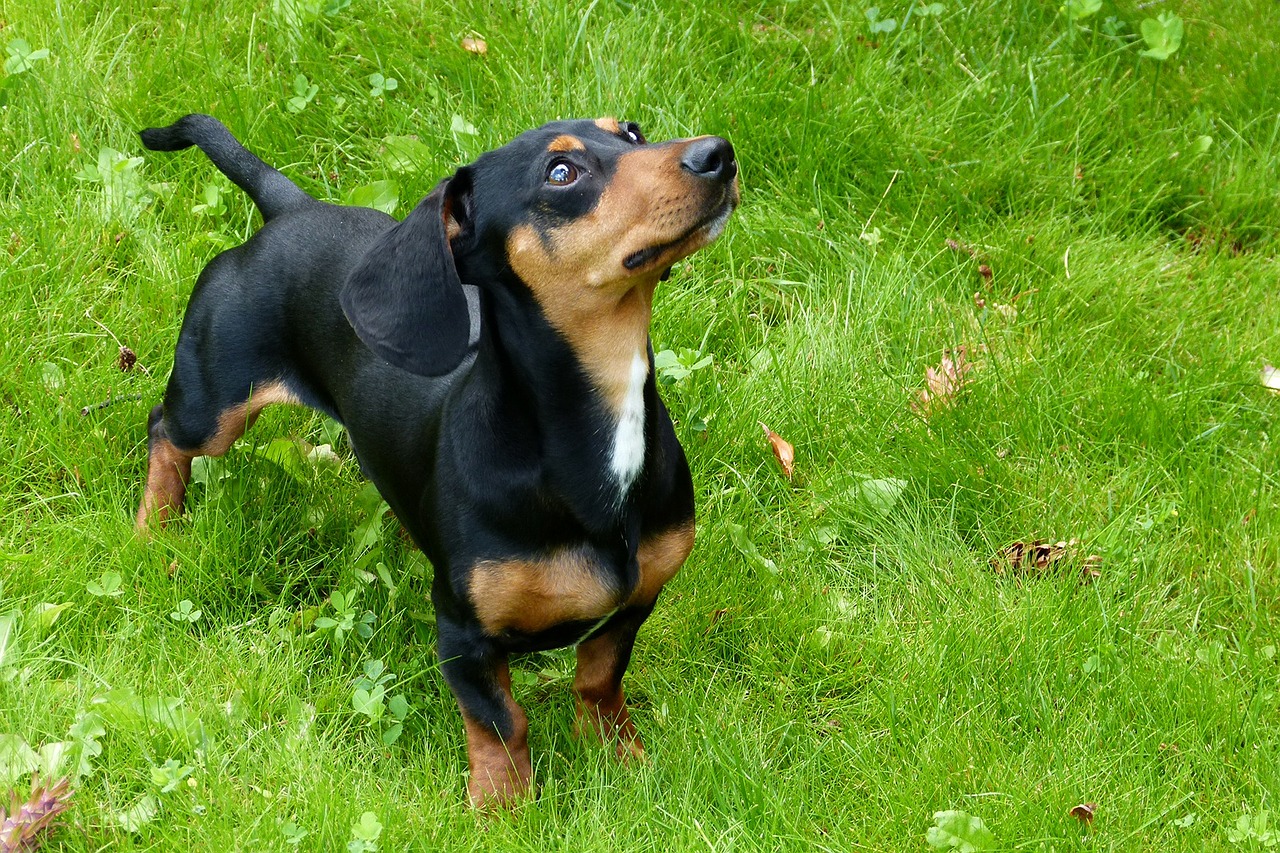
Living with our favorite long-and-short dogs is an adventure worth taking. These little babies are clever, hilarious, and endlessly affectionate. They’re ready to help with the chores, drive your car, and hunt every critter in your yard. They’ll burrow under your blankets, bark at the wind, and sit by your side when you’re sick. They’re loyal and endlessly fun.
To those of us who already live with a dachshund, it’s not really clear whether we run our houses or they do. (Okay, we all know they do!)
They have a strong temperament. Be prepared to see some of the funniest antics ever as your little sleuth responds to the world with enthusiastic joy.
Now here are some...
Quick Dachshund Facts
- Dachshunds are in the hound dog breed group.
- They’re known for their short legs and long bodies.
- Common nicknames are: doxies, dachsies, sausage dogs, wiener dogs, and hot dogs.
- Pronunciation of the word “dachshund” is DAK-sund and not “dash hound.”
- There are four sizes: toy dachshund (smallest), miniature dachshund, tweenie, and standard dachshund.
- Their average weight is under 11 pounds (toy dachshunds and miniature dachshunds), 11 to 16 pounds (tweenies), and 16 to 32 pounds (standard dachshunds).
- Their height is measured from the shoulder to the ground. 8 to 9 inches is a standard height.
- Their average life span is 12 to 15 years.
- The average litter size is 4 to 8 puppies.
- There are three varieties of dachshund fur: smooth or shorthaired; longhaired; and wire-haired.
- They come in many colors and patterns.
- They were bred to dig and they will dig holes in your yard if you let them.
- They have a loud, deep bark that people will assume is coming from a large dog. That makes them great guard dogs!
- They’re considered clever, intelligent, and mischievous.
- Dachshunds are very affectionate. They often bond most with one person and can become clingy, in a cute way.
- They’re stubborn and notoriously hard to housebreak. Vets and trainer recommend crating them on a schedule to solve this.
- They’re not easy to train. It takes a lot of patience, and will include a lot of laughter.
- They’re brave. They show it by barking and sometimes by lunging at other dogs.
- When they’re puppies especially, they’ll chew up your shoes, book covers, and other objects.
- Dachshunds are prone to becoming overweight. To keep your doxie healthy you’ll need to monitor his food intake carefully and take him on daily walks.
- Dachshunds love to jump on high things. But they can also develop herniated or slipped disks because of jumping down. So you need to keep an eye on them and place them on the ground.
- When you hold them, you need to give support to their backs with your hand.
- You should only get a dachshund from responsible breeders and rescue organizations, which you can research in advance on the Internet.
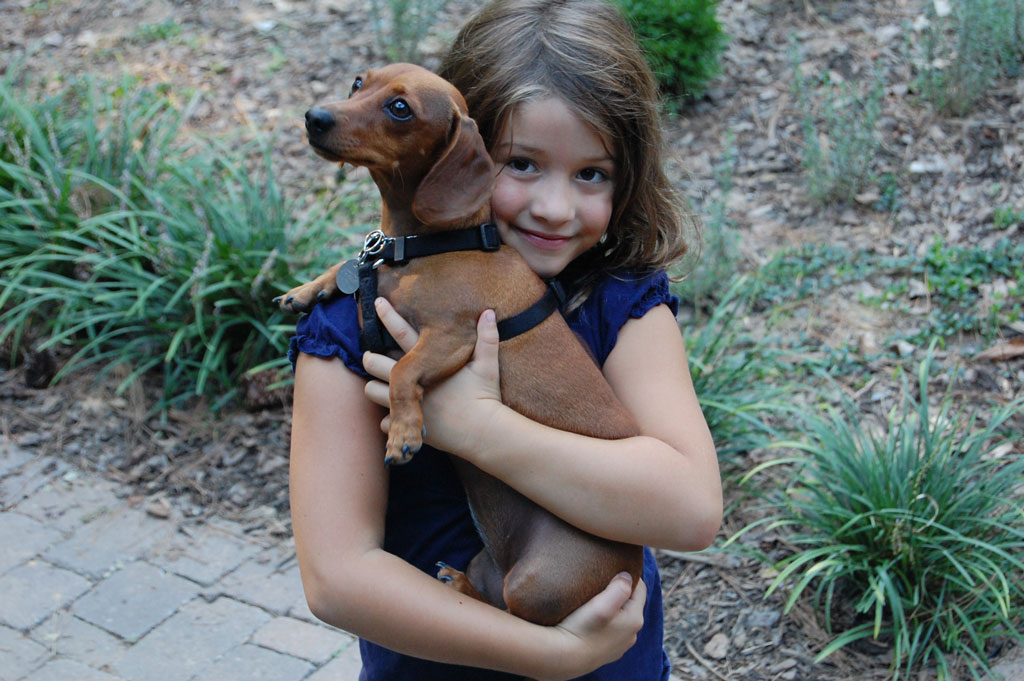
Our red mini shorthair dachshund, Cooca, when she was 1 year old. Photo by Travis Neighbor Ward
Dachshund Varieties
There are endless nicknames for dachshunds. The most common nicknames for the breed are:
- doxie (or dachsie)
- wiener dog
- hot dog
- sausage dog.
- In Germany, where dachshunds originated, they’re called dachsels and teckels.
All dachshunds share common traits and personality quirks. But there are definite differences among doxies that you should take into consideration before you buy or adopt a dog.
They come down to: size; fur type, color, and pattern; eye color; and personality.
Dachshund Sizes
When most people picture dachshunds, chances are they’re picturing miniature dachshunds because the Internet is full of photos of minis. But dachshunds come in much larger (and smaller) sizes too. Choosing the best size for you largely comes down to your lifestyle and which dachshund captures your heart. Here’s how the sizes break down, starting from the largest:
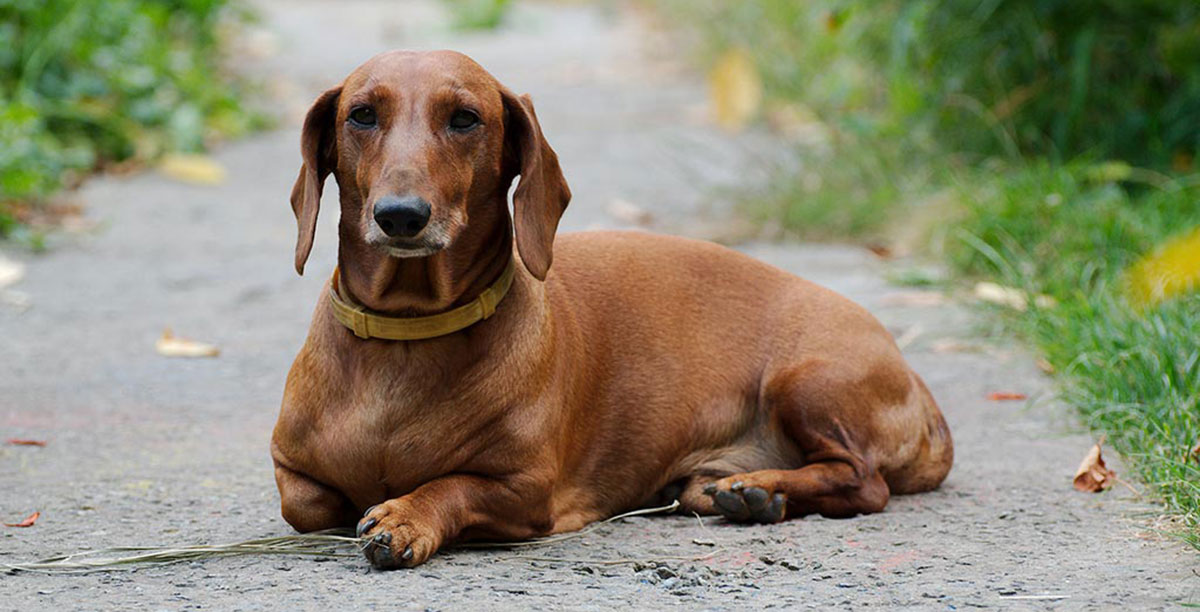
Red standard dachshund. Photo by Nick Savchenko/Flickr
Standard Dachshunds
The largest dachshunds are standard sized. They weigh between 16 and 32 pounds as adults. Here's a great example:
Tweenies
Dachshunds that weigh between 11 and 16 pounds are referred to as “tweenies.” Often miniature dachshunds enter this category when they get older and put on weight. That’s when your vet will start telling you your doxie should lose a few pounds…
When it comes to dog shows, “tweenie” isn’t recognized an official class. But they don’t hand out penalties to dachshunds that fall into this weight group.
Miniature Dachshunds
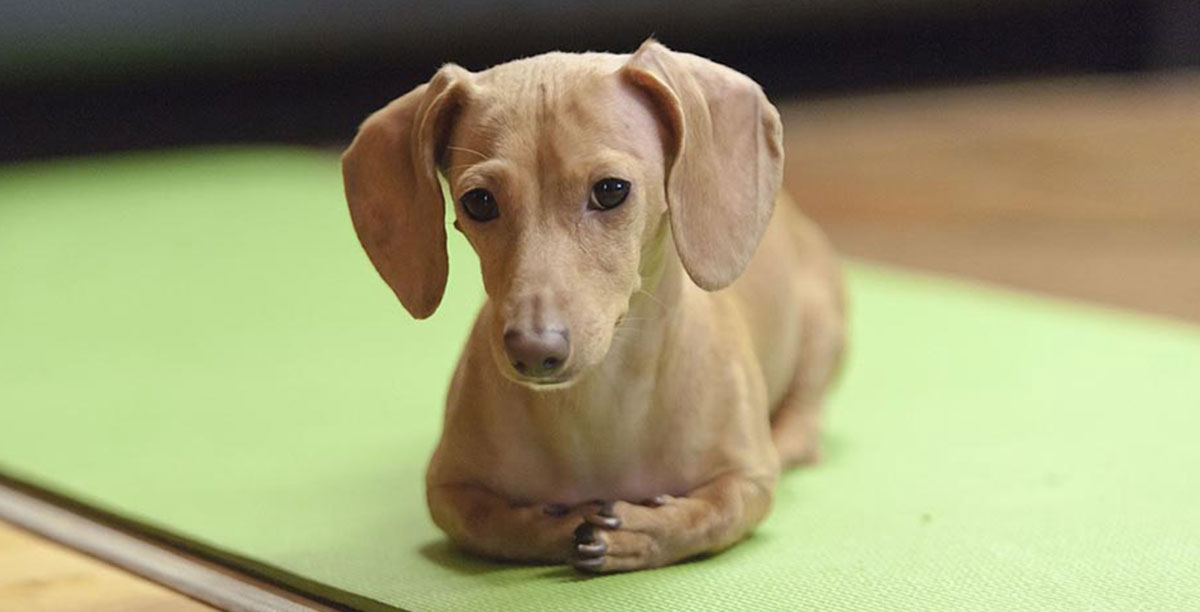
Shorthair brown miniature dachshund
Miniature dachshunds usually weigh between 8 and 11 pounds at the most when fully grown. They’re about 5to 7 inches tall at their withers, which is the top of their shoulders. They can easily fit in your arms or a small crate, and they wear small-sized coats.
Teacup Dachshunds
Finally there are toy dachshunds, which some people call “micro dachshunds” or toy doxies. They’re smaller than minis — the idea being they could fit inside a teacup. This size isn’t officially recognized as a dachshund class, and is a product of modern breeding experiments. I’d say for now the jury is out on the health of these dogs over time.
Dachshund Fur Types
There are three types of dachshunds based on fur type:
- shorthair, also called smooth
- longhair
- wire haired.
These dachshunds look very different, and people often develop a strong love for one type and stick with it as they acquire more dachshunds for their family. (Believe us, they’re irresistible!)
We’ll get into the details of each type in a sec. But first you should know that in any given littler, dachshund puppies can be born with very different fur colors and patterns. It’s based on their parents’ genetic makeup, and by taking a look at the parents of an unborn litter you can guess at what’s to come.
Dachshund Fur Patterns
Some dachshunds have a pattern in their fur that makes them really stand out. These include brindle (dark stripes on a solid-colored background), sable, dapple (merle), and piebald. Here’s a photo of my dachshund Emily, who’s no longer with us. She was a piebald and people often did a double take when they saw her!
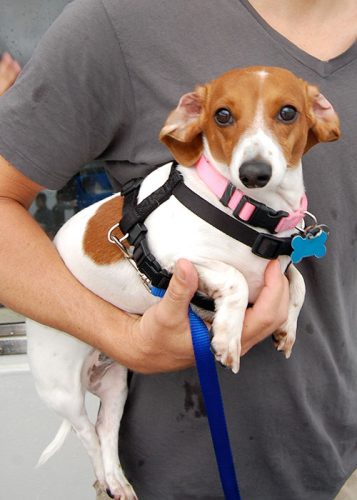
Our miniature dachshund Emily was a piebald. Wasn’t she gorgeous? Photo by Travis Neighbor Ward
Okay, now let’s get into more details about the different fur types.
The Smooth or Shorthair Dachshund
This is the most popular type of dachshund in the USA now. They don’t need any particular grooming of their fur, which is shiny and very soft to the touch. We bathe our shorthair dachshund every now and then. But we never need to brush her and she doesn't shed.
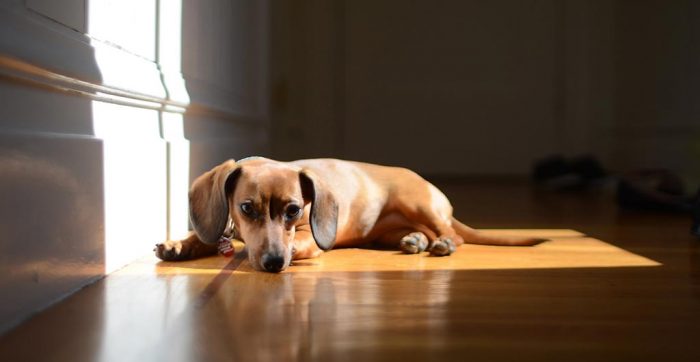
Red miniature, shorthair dachshund enjoying the sunlight
Because smooth dachshunds have a single coat of fur, they tend to get cold easily. That means you need to deck them out in a sweater or coat on chilly days. At night they’ll burrow deep under the covers to stay warm. So make sure your shorthair dachshund always has a blanket in her dogbed!
BTW: It’s believed that the longhaired and wirehaired dachshunds originally came from shorthaired dachshunds.
Here are fur colors you’ll find on a shorthair dachshund:
- red (reddish brown)
- tan
- blue and tan
- black and tan
- chocolate and tan
- Isabella (also called fawn)
- cream
- black and cream.
The Longhair Dachshund
Longhair dachshunds are soft and fluffy-looking compared to the others — and some people think they’re softer-natured in terms of personality, too.
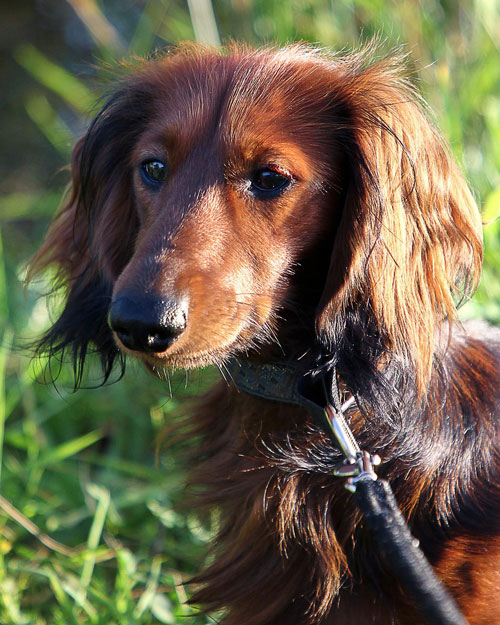
Red longhaired dachshund
Their coat is slightly wavy, and their fluffy ears hang around their face. Longhair dachshunds require more grooming than the smooth ones. If you don’t brush them daily, their fur can get matted, particularly around their ears and elbows.
These are the fur colors you’ll find on a longhair dachshund:
- red (reddish brown)
- tan
- blue and tan
- black and tan
- chocolate and tan
- Isabella (fawn)
- cream
- black and cream.
The Wire Haired Dachshund
Wire haired dachshunds are the most popular type of dachshund in Germany, where the breed originated from. They look very different from the other varieties. Their fur is short and wiry, giving their coat a somewhat rough feeling to the touch. They also have thick eyebrows and a thick beard. You will need to brush their fur often to prevent it from matting.

Brown and black wire haired dachshund. Photo by Bas Leenders/Flickr
Because their fur is heavier than shorthaired dachshunds, they don’t need to wear a coat or sweater in cold weather. Personality-wise, they’re similar to shorthaired doxies with their clever, funny minds.
People believe that breeders developed wire haired dachshunds from a cross between smooth dachshunds and dogs with hard coats — in particular, terriers and wire haired pinschers. These could include the Scottish terrier, the German wire-haired pointer, the Dandie Dinmont terrier, and the schnauzer.
As a result, wire haired dachshunds have a personality that seems to overlap more with terriers.
Wire haired dachshunds have these fur colors:
- wild boar (black, brown and gray) - the most popular color in the USA
- black and tan
- red (reddish brown)
- tan
- blue and tan
- chocolate and tan
- Isabella (fawn)
- cream
- black and cream.
Doxie Eye Colors
Different dachshunds can have different eye colors. I remember being surprised when I first saw a silvery-gray doxie with pale blue eyes. He looked magical, like something from a fairy tale!
Kennel club standards favor darker eyes. But you’ll find amber, blue, green, and light brown eyes as well Some dapple dachshunds, and double dapple dachshunds, have one blue and one brown eye.
Buying or Adopting a Dachshund
You can buy or adopt a dachshund puppy or an adult. But most of the time when people buy a weiner dog, it's a puppy. And mostly when they adopt it's an adult. I've outlined what to look for in either case below.
Buying a Doxie
There are many dachshund breeders selling puppies. Prices usually range from around $300 to $1,200 each. Breeders sell directly to people. They often place ads for upcoming litters on their websites or on websites like Craig’s List. In general people say you shouldn’t buy puppies from a pet store.
You have to do careful research before you purchase from a breeder. Many of them care for their dogs and want them to find good homes. But sometimes breeders are running “puppy mills” and the dogs are treated cruelly.
We bought both of our dachshunds from breeders because I have allergies to some dogs and wanted to be sure I wouldn’t have to give them away due to an allergic reaction. Since then my allergies have improved and we’ve also adopted a spaniel mix from a rescue agency. You need to determine which is the best option for you.
Our experience with two breeders was totally different.
Our dachshund Cocoa was born on a farm in Georgia and was allowed to run free before we got her. She was healthy and active, and her temperament is still brave and curious to this day. We paid $250 for her from a family, and we met all of Cocoa’s dachshund relatives that still lived on the farm.
We bought our dachshund Emily from a different breeder. Later we learned from news articles that the breeder was running a puppy mill. When we went to look at Emily, they wouldn’t let us out back to see the dogs and now I know why. Apparently they were keeping five or six dogs per crate, and stacking crates on top of each other. It’s no wonder Emily was so submissive and intimidated when we got her!
This breeder was selling dachshunds for $800. But Emily cost $400 because she had a strong overbite and they said no one else wanted her. We thought she was sweet and adorable, and she instantly won our hearts.
We also found out that we were the lucky ones. Many puppies from that breeder died soon after they came home. Emily only lived seven years because she developed a digestive disease. Was it because of poor breeding or nature’s way? We’ll never know. We still miss her.
One thing is certain: You should research whether any complaints have been filed against breeders. You can do this by searching their name on the Internet. People whose puppies have died won’t hesitate to post on public forums and name the breeder. There are even communities on Facebook devoted to calling out good and bad breeders.
And if you hear of a bad breeder, report them to the animal welfare authorities!
Adopting a Dachshund
Adopting a dachshund puppy that's pure-bred isn’t easy because you rarely find them at rescue centers. What you will find is mixed dachshund breeds, like dachshund-chihuahuas. (called chiweenees).
These look adorable but often quite different from pure-bred dachshunds. For example, their ears are often pointed and stick up, and their legs are longer. They can also have very different temperaments and habits.
It’s much easier to find a full-bred adult dachshund that needs to be adopted.
When dachshunds get older they can develop health issues, like back problems. To take care of these, you will pay for vet and other medical bills. Some people adopt dachshunds as puppies and then decide they can’t or just don’t want to take care of them under these circumstances. So they give up their doxies.
It’s a sad reality. But luckily there are dachshund volunteer rescue organizations across the USA that focus on finding them new homes. So I’ve put together a list of all the dachshund rescue organizations in the USA.
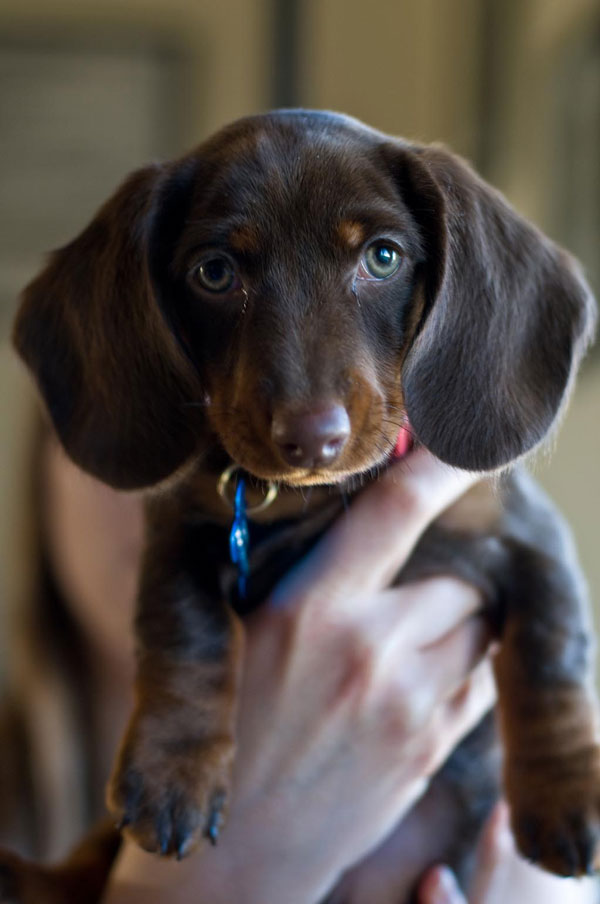
Brown shorthair mini dachshund puppy with green eyes. Photo by John Mayer/Flickr
Dachshund Exercise and Socializing
Dachshunds are fairly high energy dogs when they’re young, but they also love a good nap. As they get older, they will have periods of activity each day, but they’ll sleep more. Here are some of their favorite things to get their little legs moving.
Outdoors Time and Dog Walking
Dachshunds love being outdoors because it means coming in contact with scents. They know those scents might lead them to catching a small animal, which would be their wildest dream come true!
Another thing dachshunds love to do is leap up tree trunks. in hopes of catching a squirrel. They’ll do this even when there’s no squirrel in site. As a doxie parent you’ll get a good chuckle every time.
When you take a dachshund on a walk it’s like taking a private detective. Every leaf or blade of grass holds a clue to a puzzle that the doxie is determined to solve. Be prepared to stop OFTEN.
One dog trainer I spoke with suggested that we spend most of the walk just walking, and reserve the last part for sniffing. I wish I could say that I’ve followed her advice. But the reality is we stop all the time because I love seeing Cocoa’s joy of discovery
So if you get a dachshund, plan on getting outside!
If you have a yard with a fence, your dachshund will happily play in it for hours at a time.
But if you don’t, or you live in an apartment, dachshunds can happily stay indoors as long as you walk them a couple times a day.
Our mini dachshund could walk for hours and we’ve taken her on long hikes over miles. That’s when she was younger. Now that she’s older we limit her to a mile at a time because we don’t want to injure her back.
If it were up to Cocoa, she’d start every walk with a serious sprint!
Digging
The Dachshund is a master digger and very strong, as any doxie parent can tell you. They can dig deep holes in a short amount of time by flexing their powerful chest muscles and using their chunky little legs as spades.
Way back when the idea was for dachshunds to burrow into badger holes, fight them, and emerge with the badger in their mouth. But for those of us who live with non-hunting doxies, it boils down to enormous holes in the yard if you’re not keeping a close eye on them.
After battling this impulse in my yard, my family decided to let our little Cocoa dig away and essentially destroy part of the yard.
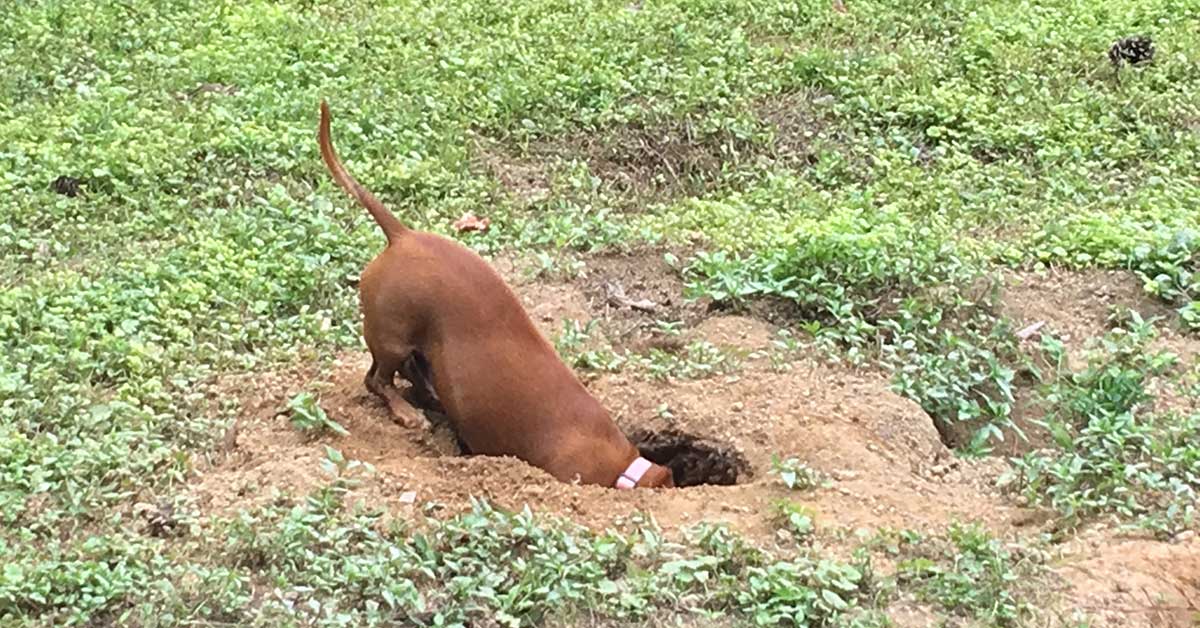
Burrowing
Another thing dachshunds love doing is burrowing. Occasionally they’ll do this in the yard by burrowing into a hole they dig — if you let the hole get deep enough. Indoors they burrow all the time under blankets and anything soft and warm lying around.
Once a dachshund gets to know and love you, she’ll enjoy burrowing in any of your clothes that you love lying around.
At night, doxies burrow to stay warm. If you let your dachshund sleep in your bed, she’ll often burrow under the covers to the very bottom of the bed and lie at (or between) your feet. It’s cute — but it can also be frustrating to try and sleep while worrying that you’ll accidentally give Pooch a kick to the head.
If you have a dog bed, make sure to put a blanket on it since dachshunds get cold even during the day.
Socializing Your Doxie with Other Dogs
Dachshunds are playful and love chasing and tumbling with other dogs. We now have a miniature dachshund and a larger spaniel mix. Even though Cocoa, our doxie, is so much smaller she plays with Poppy, our spaniel, as if they’re the same size. This often results in Cocoa being tumble onto her back or even jumped over!
It’s important to get your dachshund out to meet other dogs, particularly if you only have the one dog. Dog parks often have a section just for small dogs and your doxie will feel much more comfortable there.
As with every dog breed, it’s important to keep up to date with immunizations. Your dachshund can pick up germs at dog parks and some of the shots can prevent it from developing into a health condition.
Racing and Earthdog Den Trials
There are two sports that people sometimes enter their dachshunds into: races and Earthdog Den Trials. I believe in sharing news about all things dachshund. But please note that I’m not promoting either of these activities.
Dachshund Races
There are some dachshund parents that enter their doxies in races like the Wiener Nationals. You can find lots of photos from them on the Internet. But the Dachshund Club of America doesn’t condone them because of the dangers to the dachshunds’ backs.
Earthdog Den Trials
Another dachshund sport is the Earthdog Den Trials. During this event dachshunds must enter tunnels, lairs, or dens and hunt for prey. These tunnels have obstacles built into them, as well as dead ends. The prey is either rats that have been places in cages, or fake prey.
The winner is the first dog the succeeds in chasing the prey out into the open, or keeping it there until the hunter digs down. Dogs who score 100% get a Certificate of Gameness.
People say that the rats in these trials are protected and can’t be hurt. But surely they’re terrified.
For more about how these trials work, you can look at the website of the American Working Terrier Association. A good Canadian website with details about these trials is this one.
Dachshund Care
The amount of care your dachshund needs depends partly on what type of fur he has. The main doxie care you need to know about includes dental hygiene, nails, baths, and hair grooming.
Dachshund Health Issues
Dachshunds are generally healthy dogs when they’re younger, and they can stay healthy all their life. But some wiener dogs suffer from back and weight problems, eye problems, diabetes, knee problems, and more.
What to Ask a Breeder
If you’re getting a dachshund puppy or adult dog from a reputable breeder, they should be able to tell you about your dog’s health history. That includes your dog’s health and the health of his parents. There are tests that breeders can pay for, to determine any current health problems. Genetic tests can also predict future health problems.
If the breeder has done his homework, he can show you proof of good health from licensed vets. Since health clearances can’t be done until a dog is at least 2 years old, it’s important to ask about the parents’ health. This is also why people discourage breeding dogs that are under 2.
For dachshunds the minimum you should expect to see is a Canine Eye Registry Foundation (CERF) heath clearance. This clearance will tell that the dog’s eyes are normal.
Hearing Problems
Dachshunds don’t usually develop hearing loss. But sometimes they do, and it’s apparently more common in dachshunds with the double dapple coat pattern.
If you’re choosing a puppy from a breeder, you can ask whether a vet has tested the puppy or his doxie parents for Brainstem Auditory Evoked Response or BAER. This test indicates any hearing loss.
On puppies, they can only do this test after the puppy is five weeks old. It’s only available in some veterinary hospitals, schools, and specialized vet practices.
Color Dilution Alopecia
If you have a Blue, Isabella, or Fawn dachshund, you may run into Color Dilution Alopecia. This is a skin disorder that can affect these "dilute color" doxies. It leads to high sensitivity to sunlight and hair loss.
My Conclusion
Having our dachshunds changed my life in countless, wonderful ways. I never had dogs before we got Emily, and she taught me so much. When I had cancer, she and Cocoa showed me, by example, how to enjoy every day more and how to live in the moment better.
Emily stayed by my side when I was recovering from surgery, and they were always there to give me kisses. And when they needed me, I was there for them. I can't imagine ever again living without dachshunds!
- Travis Neighbor Ward



